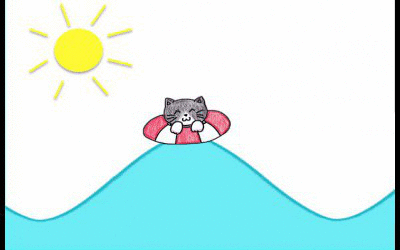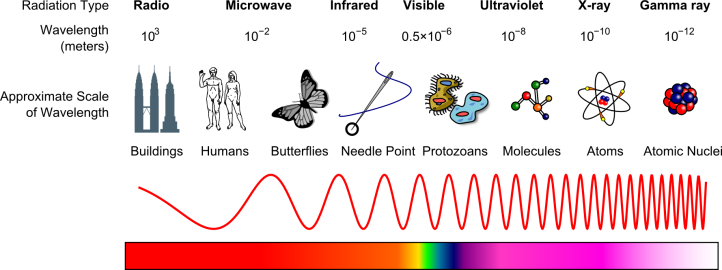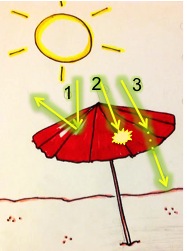Spring is officially here and I don’t know about you, but I’m excited to welcome back COLOR: the bright rays of sunshine, the baby blue sky, the lively green grass, and of course, the plethora of vibrantly colored flowers. But have you ever wondered what is color? To understand the marvels of color and how it can be used to help nanomaterials kill cancer cells, let’s first connect color to the concepts of light and waves together!
Let’s first go to the beach and talk about waves! You and I are about to go for a swim when we decide to put my water-loving cat, Totoro, into a lifesaver and watch him catch some waves.

We notice that he is bobbing up and down quite regularly, tracing the same path as the waves in the ocean. If we want to describe Totoro’s motion, we can say that he is moving in a periodic manner. To be even more quantitative, we can say that he is bobbing up and down at a specific frequency; where we define frequency to be how many times Totoro bobs up and down per second. If the waters are calm, maybe Totoro only catches one wave per second. But if the waters are rough, Totoro may catch 5 waves in one second (and we probably shouldn’t have put him in the water…yikes!). We can say that 1 wave per second is a smaller frequency than 5 waves/second. All waves have a frequency!
So what exactly do my cat Totoro and waves have to do with light and color? Well, as it turns out, light is a wave and therefore, from what we discussed, it must have a frequency. What is even more awesome is that we already have a term for the frequency of light that our eyes detect: COLOR! Color is simply a measure of how fast the light waves are bobbing up and down. Unlike the waves in the ocean, the waves of light move up and down much, much quicker at a frequency of several billion waves per second. While we can count how many times Totoro bobs up and down on an ocean wave, we can’t count the billions of light wave peaks per second that pass into our eyes. Instead, our eyes interpret this as color.

Although all light has a frequency, the range of frequencies that our eyes are biologically tuned to see is known as the visible spectrum. The lowest frequency of light that we can see is red and the highest is purple. The visible spectrum is the continuous band of color that ranges from red to purple. This visible spectrum is actually one region in a much larger continuous band of frequencies known as the electromagnetic spectrum.
How does this translate to say, a red umbrella we had at the beach? Well, light is pretty awesome and it can interact with your favorite red umbrella in these ways: 1.) Some of the light will bounce (or reflect) off the umbrella, 2.) Some of the light will be absorbed into the umbrella which you can notice by feeling how much warmer the umbrella is in the sun, and 3.) Some of the light will pass (or transmit) through the umbrella and hit your skin. The umbrella appears red in color because it is reflecting more red light than any other light coming towards it. This phenomenon is true of everything else you may have with you at the beach; including the black slippers that are too hot to wear after being in the sun too long. Black objects absorb more visible light than they reflect. Therefore, they heat up much more quickly than colored or white objects, as the light energy they absorb gets converted into thermal energy.

As it turns out, scientists have taken advantage of these properties of light and applied them to a technique known as photodynamic therapy. This can potentially offer a viable treatment for cancer. There are currently three different FDA approved drugs that use this technique.
Currently, many chemotherapy drugs target rapidly dividing cells, like most cancer cells. However, other cells in our digestive tract, hair follicles, and bone marrow also divide rapidly under normal conditions. This explains many of the negative aspects of chemotherapy, as it can kill healthy cells as well as cancer cells. Scientists use the term ‘nonselective’ to describe this behavior.
Photodynamic therapy, on the other hand, offers a more selective method of killing cancer cells. Many researchers are exploring the use of nanomaterials in photodynamic therapy. In 2010, Kirui et al showed that cancer cells could be tricked into allowing nanoparticles to enter inside. Once they are inside the cancer cells, we can shine a high-intensity light wave with a specific frequency that is designed to transmit right through human skin and tissue but be absorbed by the nanoparticles. Similar to how your black slippers heat up at the beach, these nanoparticles would also heat up after absorbing the light. This heat kills the cancer cells by “burning them up”.
So the next time you go to the beach, remember: don’t leave your black slippers out in the sun! It’s going to be hot! You may even look at the waves and think of how a cat bobbing in the water is related to light and color. Here’s to wishing us all a wonderful spring and summer season to come: enjoy the breathtaking colors all around you!

[…] is simply a matter of certain wavelengths of sunlight bouncing off the pigment, as explained in this blog post. Either way, our eyes are processing light waves with a wavelength around 521 nanometers, the […]
[…] know that the unique properties of nanomaterials give rise to many amazing potential applications: turning light into a weapon against cancer, changing how we generate or store energy, speeding up chemical reactions, or allowing us to make […]